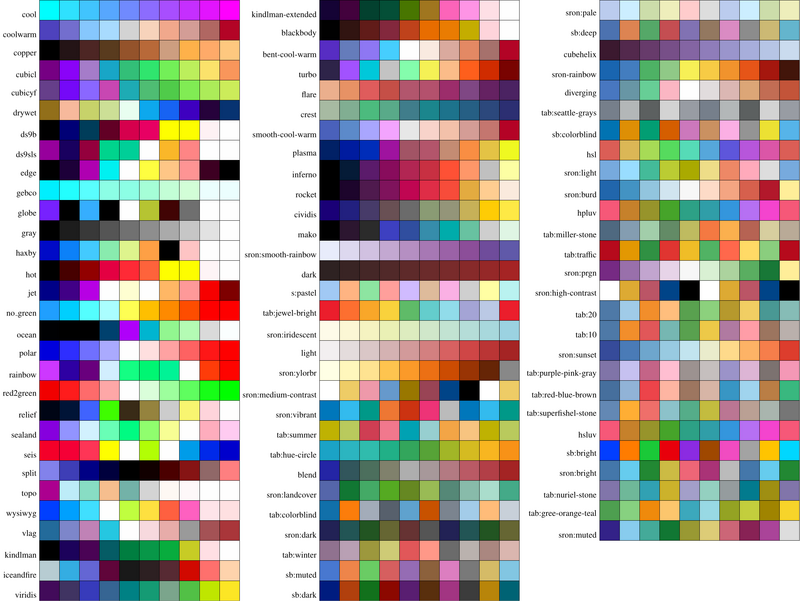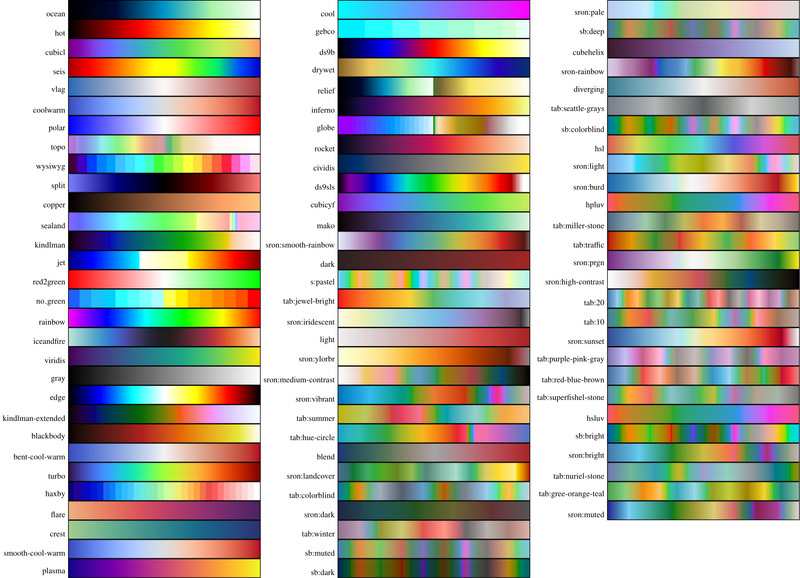For all your color needs!
Jump to navigation
Jump to search
This is a simple script to create two PDFs showing the defined colors in the isisscripts. Some of them are created via generator functions and allow a great deal of customization. You really should consult the help.
require("tikz");
%% Plot all palettes with tikz
define tikz_color_test (filename)
{
variable C = {}; % these are just collectors for nicer alignment
variable V = {};
variable n,j=0;
% loop through all maps and palettes
foreach n ([png_get_colormap_names(), get_color_palette_names()])
{
% this is the color interface access: We request a palette with name 'n'
% and 10 colors. In case it is a static palette we only get the total
% number of colors, the repeat qualifier ensures we get an array of
% length 10, with repeated colors.
variable pal = get_color_palette(n, qualifier("n", 10); repeat);
% all returned palettes are generated with the default parameter settings
% many can be customized for your needs! You really should check the
% help entries.
if (j == 30)
{
list_append(C, tikz_new_vbox_compound(__push_list(V)));
V = {};
j = 0;
}
variable H = {};
variable i;
_for i (0,qualifier("n", 10)-1)
{
% Put the colors in boxes together
list_append(H, tikz_new_rectangle(0,0,1,1; fillcolor=sprintf("#%06x", pal[i])));
}
% label it
list_append(V, tikz_new_hbox_compound(tikz_new_text(0,0,strreplace(n,"_","\\_"); anchor="south east"),
__push_list(H)));
j++;
}
% to capture the remaining palettes
if (length(V)>0)
list_append(C, tikz_new_vbox_compound(__push_list(V)));
% put everything together
tikz_new_hbox_compound(__push_list(C), 4).render(filename);
}
define tikz_map_test (filename)
{
variable V = {}; % collectors again
variable H = {};
variable n, map, i = 0;
% and again loop over maps and palettes
foreach n ([png_get_colormap_names(), get_color_palette_names()])
{
if (i == 30)
{
list_append(H, tikz_new_vbox_compound(__push_list(V)));
V = {};
i = 0;
}
% get a color map, this is different from 'png_get_colormap' as it allows
% also a palette name (just a (small) number of colors) and interpolates between
% them. Also has parameters, see the help.
map = get_color_map(n);
% to make it simple just plot some pictures
variable p = tikz_plot_new(10, 1);
p.axis(; off);
p.plot_png(_reshape([0:255], [1, 256]); cmap=map, depth=200);
p.plot([0,0,1,1,0], [0,1,1,0,0]; width=2, color="black", world0);
list_append(V, tikz_new_hbox_compound(tikz_new_text(0,0,strreplace(n,"_", "\\_"); anchor="south east"),
p; interleave));
i++;
}
if (length(V)>0)
list_append(H, tikz_new_vbox_compound(__push_list(V)));
% and puth everything together
tikz_new_hbox_compound(__push_list(H), 4).render(filename);
}
% run both!
tikz_color_test("palettes.pdf");
tikz_map_test("maps.pdf");
% and enjoy your creation :)
exit();

